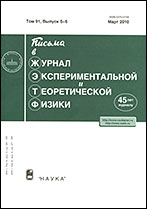|
|
Pis'ma v Zhurnal Èksperimental'noi i Teoreticheskoi Fiziki, 2011, Volume 93, Issue 1, Pages 8–12
(Mi jetpl1795)
|
 |
|
 |
This article is cited in 5 scientific papers (total in 5 papers)
CONDENSED MATTER
Diffusion of insoluble carbon in zirconium oxides
V. B. Vykhodetsa, T. E. Kurennykha, A. G. Kesareva, M. V. Kuznetsovb, V. V. Kondrat'eva, C. Hülsencd, U. Koesteref
a Institute of Metal Physics, Ural Division of the Russian Academy of Sciences
b Institute of Solid State Chemistry, Urals Branch of the Russian Academy of Sciences
c Institut für Festkörperphysik, Universität Jena, D-07743 Jena, Germany
d Layertec GmbH, Ernst-Abbe-Weg 1, D-99441 Mellingen, Germany
e Institut Laue Langevin, F-38042 Grenoble Cedex 9, France
f CERN, ISOLDE, CH-1211 Geneva 23, Switzerland
Abstract:
The diffusion coefficient of insoluble carbon in zirconium oxides has been obtained for the temperature range of 900–1000$^\circ$C. There are no published data on the diffusion of insoluble impurities; these data are of current interest for the diffusion theory and nuclear technologies. Tracer atoms $^{13}$C have been introduced into oxides by means of ion implantation and the kinetics of their emission from the samples in the process of annealing in air has been analyzed. The measurements have been performed using the methods of nuclear microanalysis and X-ray photoelectron spectroscopy. The diffusion activation energy is 2.7 eV and the carbon diffusion coefficient is about six orders of magnitude smaller than that for oxygen self-diffusion in the same systems. This result indicates the strong anomaly of the diffusion properties of carbon in oxides. As a result, zirconium oxides cannot be used in some nuclear technologies, in particular, as a material of sources for accelerators of short-lived carbon isotopes.
Received: 28.10.2010
Citation:
V. B. Vykhodets, T. E. Kurennykh, A. G. Kesarev, M. V. Kuznetsov, V. V. Kondrat'ev, C. Hülsen, U. Koester, “Diffusion of insoluble carbon in zirconium oxides”, Pis'ma v Zh. Èksper. Teoret. Fiz., 93:1 (2011), 8–12; JETP Letters, 93:1 (2011), 5–9
Linking options:
https://www.mathnet.ru/eng/jetpl1795 https://www.mathnet.ru/eng/jetpl/v93/i1/p8
|


|





 Contact us:
Contact us: Terms of Use
Terms of Use
 Registration to the website
Registration to the website Logotypes
Logotypes








 Citation in format
Citation in format 
